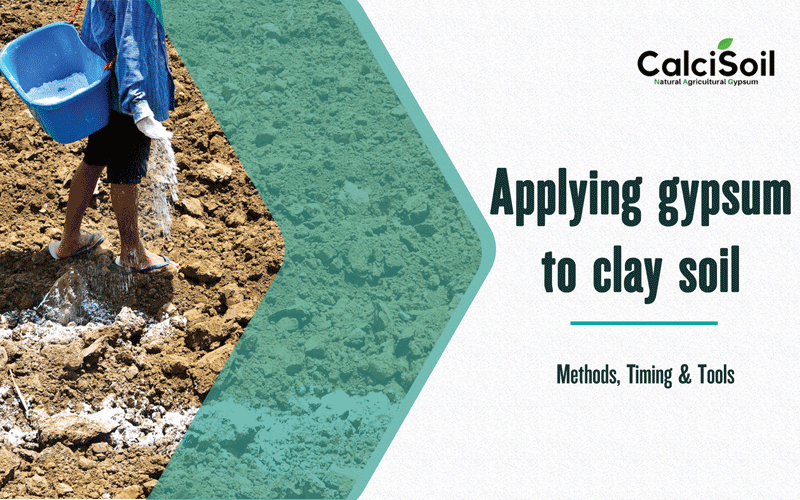
How to apply gypsum to clay soil?
Applying gypsum for clay soil can help improve its structure, drainage, and nutrient availability. Here’s how to do it effectively:
- Determine the Application Rate
For hard, heavy, compacted clay soil, apply 1-3 kg (4-12 cups) of gypsum per square meter.
For lawns, vegetables, flowers, trees, and shrubs, apply 0.5-1 kg (2-4 cups) per square meter.
- Prepare the Soil
If applying to an established garden bed, disturb the mulch to expose the soil.
For new plantings or lawns, till the gypsum into the top 10-15 cm of soil before planting.
- Spread the Gypsum Evenly
Sprinkle the gypsum over the soil surface, ensuring even coverage.
Use a hoe, rake, or trowel to lightly mix the gypsum into the soil or mulch.
- Water the Area
After applying, water the area thoroughly to help dissolve the gypsum and move it into the soil profile.
Aim to water until the gypsum is no longer visible on the surface.
- Repeat Application
For best results, apply gypsum twice a year, in spring and autumn.
It may take several months to see the full effects of the gypsum on soil structure.
Remember, gypsum is most effective on clay soils with a clay content of 30% or more. It will have limited benefits on well-draining, sandy soils.
How often should gypsum be reapplied to clay soil?
Gypsum is commonly used to improve clay soil, and its application frequency can vary based on specific soil conditions and desired outcomes.
Recommended Application Frequency
Annual Application: It is generally advised to apply gypsum once a year. This is because gypsum works slowly in the soil, and reapplying too frequently may not yield additional benefits.
Biannual Application: Some sources recommend applying gypsum to clay soil twice a year, specifically in spring and autumn, to maximize its benefits, especially for heavy clay soils.
Effectiveness and Longevity
Short-Term Effects: Gypsum acts relatively quickly in improving soil structure but is effective for only a few months due to its solubility in water. Thus, it may need to be reapplied periodically to maintain its benefits.
Long-Term Benefits: While the sulfate component of gypsum may leach away within 18 months, the calcium remains in the soil for much longer, potentially benefiting soil structure for decades.
Signs that gypsum needs to be reapplied to clay soil include:
Soil Structure Deterioration: If the soil becomes compacted again, indicating that the benefits of the previous gypsum application have diminished, it may be time to reapply.
Poor Drainage: If water is pooling on the surface or draining poorly, this can signal that the gypsum’s effectiveness has decreased, necessitating another application.
Leaching in Wet Conditions: In wet climates or irrigated fields, gypsum can leach out of the soil profile. If you notice a decline in soil quality or structure, this could indicate that gypsum needs to be reapplied.
Soil Testing Results: Regular soil testing can help determine if calcium levels are low or if soil structure has not improved, suggesting the need for more gypsum.
Visual Indicators: Signs such as increased clayiness or difficulty in tilling the soil can also indicate that the gypsum’s effects have worn off and reapplication is needed.
Generally, gypsum may need to be reapplied every couple of years, particularly in conditions where leaching occurs, to maintain its beneficial effects on clay soil.
Recommended tools for Applying gypsum to clay soil

For applying gypsum to clay soil, the following tools are recommended:
Fertilizer or Litter Spreader: This is the most effective tool for spreading gypsum evenly across a large area. Ideally, it should have a stainless steel box with steep sides (45° angles) and a wide belt to prevent bridging of the gypsum particles during application.
Broadcast Spreader: Similar to a fertilizer spreader, a broadcast spreader can also be used for even distribution of gypsum.
Tiller or Rake: After spreading gypsum, a tiller or rake can help incorporate it into the soil, ensuring better penetration and effectiveness.
Watering Equipment: A hose or irrigation system may be necessary to water the area after application, helping to dissolve the gypsum and facilitate its movement into the soil.
Calibration Tools: It’s important to calibrate the spreader before application to ensure the correct amount of gypsum is applied. This may involve using weights or measuring devices to check the spread rate.
Using these tools will help ensure that gypsum is applied effectively, enhancing soil structure and drainage in clay soils.







